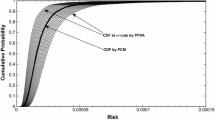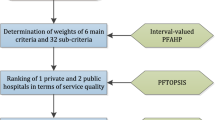Abstract
In this paper, we present a hierarchical fuzzy model to support patient triage in primary health care. In developing countries like Brazil, public health must usually cover degraded territories; thus, allocating patients to health services is very hard due low availability, enormous demands, and the complexity of assessing patient conditions—which must account for more then physical aspects of patients, but their social conditions as well. This approach combines the fuzzy set theory under the AHP framework in order to illustrate the inherent imprecision in the evaluation of patient risk. Fieldwork was conducted in a primary healthcare facility in Brazil to demonstrate the applicability of the proposed approach. The proposed approach represents criterion in the formation of patients’ risk scores encompassing important aspects of primary care triage such as the structure of families, the conditions of residences, exposure to urban violence, and other aspects of patients’ lives, taking the risk assessment beyond the simple evaluation of symptoms and physiological conditions. Our approach focuses on enforcing decisions of public health workers by improving the awareness of patients’ conditions, which we believe will make the employment of triage criteria uniform and capable of showing tendencies on patients’ risks, as well as avoiding bias in patient triage.







Similar content being viewed by others
References
Ashour OM, Okudan, GE, Smith CA (2010) An improved triage algorithm for emergency departments based on fuzzy AHP and utility theory. In: Johnson A, Miller J (eds) Proceedings of the 2010 industrial engineering research conference
Bartolin R, Bouvenot G, Soula G, Sanchez E (1982) The fuzzy set theory as a biomedical diagnostic aid. Sem Hop 58(22):1361–1365
Gharahighehi A, Kheirkhah AS, Bagheri A (2016) Improving performances of the emergency department using discrete event simulation DEA and the MADM methods. Digital Health 2:1–14. https://doi.org/10.1177/2055207616664619
Gong Z, Lin Y, Yao T (2012) Uncertain fuzzy preference relations and their applications. Springer, Berlin
Grecco CH, Consenza CA, Dos Santos IJ, Carvalho PV (2014) Safety culture assessment: a fuzzy model for improving safety performance in a radioactive installation. Prog Nuclear Energy 70:71–83
Jatoba A, Bellas HC, Bonfatti RJ, Burns CM, Vidal MR, Carvalho PR (2016) Designing for patient risk assessment in primary health care: a case study. Cognit Technol Work 18(1):215–231. https://doi.org/10.1007/s10111-015-0355-x
Klein G (1997) An overview of naturalistic decision making applications. In: Zsambok CE, Klein G (eds) Naturalistic decision making. Lawrence Erlbaum Associates, Mahwah, pp 49–59
Lee C, Ru C, Yeung C, Choy K, Ip W (2015) Analyze the healthcare service requirement using fuzzy QFD. Comput Ind 74:1–15
Manchester Triage Group (2005) Emergency triage. Wiley, Manchester
Moumjid N, Gafni A, Brémond A, Carrère M-O (2007) Shared decision making in the medical encounter: Are we all talking about the same thing? Med Decis Mak 27(5):539–546
Rahimi SA, Jamshidi A, Ruiz A, Ait-kadi D (2016) A new dynamic integrated framework for surgical patients’ prioritization considering risks and uncertainties. Decis Support Syst 88:112–120. https://doi.org/10.1016/j.dss.2016.06.003
Saaty TL (1977) A scaling method for priorities in hierarchical structures. J Math Psychol 15(3):234–281
Saaty TL (1990) How to make a decision: the analytic hierarchy process. Eur J Oper Res 48(1):9–26
Saay RW (1987) The analytic hierarchy process: what it is and how it is used. Math Model 9(3–5):161–176
Samuel O, Omisore M, Ojokoh B (2013) A web based decision support system driven by fuzzy logic for the diagnosis of typhoid fever. Expert Syst Appl 40:4164–4171
Sanchez A (1998) Fuzzy logic and inflammatory protein variations. Clin Chim Acta 270:31–42
Savassi LC, Carvalho HR, Mariano FM, Lamberti C, Mendonça MF, Yamana G, Pereira R (2012a) Proposal of a protocol for individual risk classification for home care in primary health. J Manag Prim Health Care 3(2):151–157
Savassi L, Lage J, Coelho F (2012b) Systematization of a stratification questionnaire for family risk: Coelho-Savassi’s Family Risk Scale. J Manag Prim Health Care 3(2):179–185
Schmidt T, Wiil UK (2015) Identifying patients at risk of deterioration in the Joint Emergency Department. Cognit Technol Work 17(4):529–545. https://doi.org/10.1007/s1011
Strauss A, Corbin J (1998) Basics of qualitative research: techniques and procedures for developing grounded theory, 2nd edn. Sage, Thousand Oaks
Yu PL, Chiang CY (2002) Decision making, habitual domains and information technology. Int J Info Tech Decis Mak 1(1):5–26
Zadeh LA (1965) Fuzzy sets. Inf Control 1(8):338–353
Zadeh LA (1975a) Fuzzy logic and approximate reasoning. Synthese 30(3–4):407–428
Zadeh LA (1975b) The concept of a linguistic variable and its application to approximate reasoning—I. Inf Sci 8(3):199–249
Acknowledgements
We would like to thank the family healthcare professionals who participated in this study and the staff of the Germano Sinval Faria Health Care Center and School/Oswaldo Cruz Foundation led by Dr. Emilia Correia.
Funding
This research has been partially funded by the Science without Borders Program/Brazilian National Council for Scientific and Technological Development and by the Group of Ergonomics and New Technologies/Federal University of Rio de Janeiro.
Author information
Authors and Affiliations
Corresponding author
Rights and permissions
About this article
Cite this article
Jatobá, A., Bellas, H.C., Koster, I. et al. Supporting decision-making in patient risk assessment using a hierarchical fuzzy model. Cogn Tech Work 20, 477–488 (2018). https://doi.org/10.1007/s10111-018-0475-1
Received:
Accepted:
Published:
Issue Date:
DOI: https://doi.org/10.1007/s10111-018-0475-1




